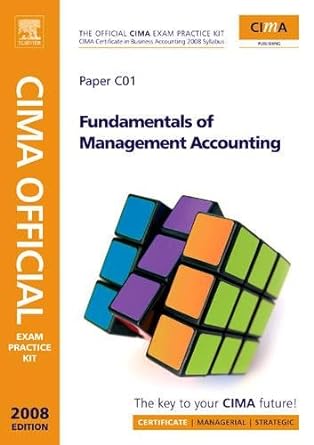Question
1) In a period, opening stocks were 12,600 units and closing stocks 14,100 units. The profit based on marginal costing was $50,400 and profit using
1) In a period, opening stocks were 12,600 units and closing stocks 14,100 units. The profit based on marginal costing was $50,400 and profit using absorption costing was $60,150. The fixed overhead absorption rate per unit is
(A) $4.77.
(B) $6.50.
(C) $6.77.
(D) None of the above
2) Under the FIFO process costing method, the two categories of completed units used to compute the total cost of units completed during a period are
(A) beginning work-in-process units and units started
(B) units started and completed and ending work-in-process units.
(C) beginning work-in-process units and units started and completed during the current period.
(D) None of the above.
3) The following are the different methods used to assign overhead costs to cost objects: (i) plantwide rate (ii) departmental rate (iii) activity-based costing activity rate Rank these methods of assigning overhead costs from least accurate to most accurate:
(A) (i), (ii), (iii)
(B) (ii), (i), (iii)
(C) (i), (iii), (ii)
(D) (iii), (ii), (i)
4) Which of the following costs are always irrelevant in decision making?
(A) Avoidable costs
(B) Sunk costs
(C) Opportunity costs
(D) Fixed costs
5) Research has shown that managers perform best when
(A) there is no budget to worry about.
(B) budgets contain a maximum of slack.
(C) there is a moderately difficult but achievable budget.
(D) the budget is obviously unachievable, but presents a tremendous challenge.
Step by Step Solution
There are 3 Steps involved in it
Step: 1

Get Instant Access to Expert-Tailored Solutions
See step-by-step solutions with expert insights and AI powered tools for academic success
Step: 2

Step: 3

Ace Your Homework with AI
Get the answers you need in no time with our AI-driven, step-by-step assistance
Get Started


